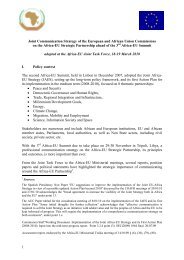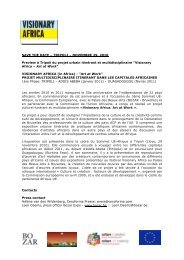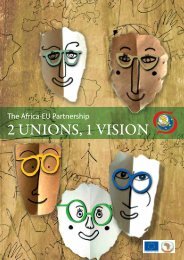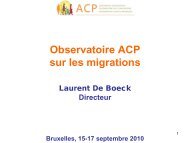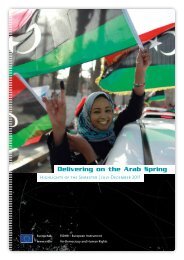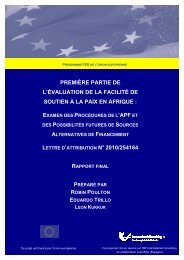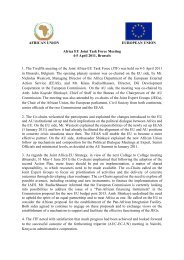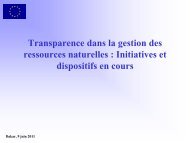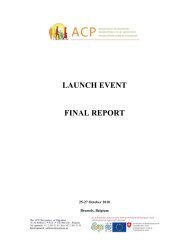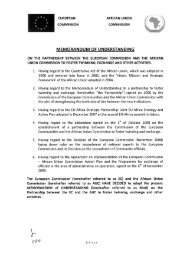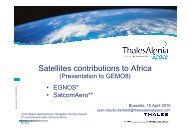part 1 of the african peace facility evaluation - European ...
part 1 of the african peace facility evaluation - European ...
part 1 of the african peace facility evaluation - European ...
Create successful ePaper yourself
Turn your PDF publications into a flip-book with our unique Google optimized e-Paper software.
EXECUTIVE SUMMARY<br />
EU foreign policy towards Africa has evolved in <strong>the</strong> context <strong>of</strong> successive EDFs and <strong>the</strong> Cotonou<br />
Agreement (successor to Lomé) over more than half a century. In response to <strong>the</strong> request <strong>of</strong> <strong>the</strong><br />
African Union (AU) in 2003, <strong>the</strong> EU created, under <strong>the</strong> 9 th EDF, a new foreign policy financial<br />
instrument, <strong>the</strong> Africa Peace Facility (APF), based on <strong>the</strong> philosophy <strong>of</strong> building a “developmentsecurity<br />
nexus” as sustainable economic development can only take place in conditions <strong>of</strong> <strong>peace</strong> and<br />
security.<br />
Under <strong>the</strong> 10 th EDF, <strong>the</strong> APF Action Plan 2008-2010 includes as a general objective to contribute to<br />
<strong>the</strong> African <strong>peace</strong> and security agenda through targeted support at continental and regional levels in<br />
<strong>the</strong> areas <strong>of</strong> conflict prevention, management and resolution, and <strong>peace</strong> building. The APF addresses<br />
<strong>peace</strong> and security following <strong>the</strong> underlying principles <strong>of</strong> <strong>the</strong> Joint Africa – EU strategy (JAES) 1 :<br />
ownership, <strong>part</strong>nership and solidarity. The 2008-2010 APF specific objectives meet <strong>the</strong> three priorities<br />
<strong>of</strong> <strong>the</strong> Africa-EU <strong>part</strong>nership on Peace and Security under <strong>the</strong> First Action Plan (2008-2010), namely:<br />
‣ provide funding for African-led <strong>peace</strong>-keeping operations (PSOs)<br />
‣ operationalise <strong>the</strong> African Peace and Security Architecture (APSA)<br />
‣ promote a dialogue on challenges to <strong>peace</strong> and security in Africa.<br />
APSA is made up <strong>of</strong> several components and structures and includes eight African regional<br />
organisations (RECs), in <strong>part</strong>icular an AU Peace and Security Council (PSC), which is <strong>the</strong> central AU<br />
decision-making body; a Continental Early Warning System (CEWS); a 'Panel <strong>of</strong> <strong>the</strong> Wise', with a<br />
mandate in conflict prevention and resolution, and an African Standby Force (ASF) to be deployed in<br />
<strong>peace</strong> support operations. This EU commitment was renewed at <strong>the</strong> 3rd Africa EU Summit held in<br />
Tripoli in November 2010.<br />
The present report refers to Part I <strong>of</strong> a comprehensive <strong>evaluation</strong> <strong>of</strong> <strong>the</strong> APF: policy-oriented<br />
review focusing on <strong>the</strong> procedures <strong>of</strong> <strong>the</strong> APF and possibilities <strong>of</strong> alternative future sources <strong>of</strong><br />
funding. Part II will be a substantive <strong>evaluation</strong> <strong>of</strong> <strong>the</strong> overall implementation and results.<br />
Despite any reservations over financial procedures, <strong>the</strong> APF has transformed <strong>the</strong> way in which <strong>the</strong> AU<br />
and <strong>the</strong> EU are perceived in Africa, making <strong>the</strong>m significant players in <strong>the</strong> <strong>peace</strong> and security sector.<br />
Each category <strong>of</strong> stakeholders (AU and AU MS, international and regional organisations, CSOs in<br />
Europe and Africa) speaks positively about APF and its achievements. The recent events in North<br />
Africa remind us that Europe has a direct interest in creating a strong African security infrastructure<br />
functioning all <strong>the</strong> way down from <strong>the</strong> AU Peace and Security Council in Addis, to <strong>the</strong> distant frontiers<br />
where conflicts occur.<br />
Since <strong>the</strong> creation <strong>of</strong> APF in 2003, 2 <strong>the</strong> instrument has evolved considerably, both in scope (under <strong>the</strong><br />
JAES) and financial potential. The following table summarises <strong>the</strong> main changes in <strong>the</strong> APF between<br />
<strong>the</strong> 9 th and 10 th EDF:<br />
1 Adopted in December 2007.<br />
2 For a detailed history <strong>of</strong> APF’s evolution, see annex 1.<br />
Page 1 <strong>of</strong> 49




